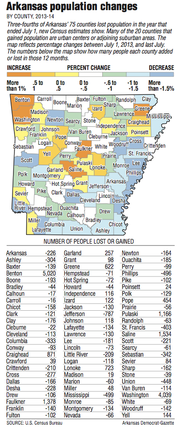Three-fourths of the state's counties lost population between 2013 and 2014, new federal census numbers show, and the counties that grew in population gained a total of 16,876.
Counties that grew in population were mostly in the state's urban areas, particularly the northwest corner of the state.
Benton and Washington counties accounted for nearly half of the state's growth of 0.3 percent, adding 7,604 residents.
The Northwest Arkansas metropolitan statistical area passed the half-million mark last year, growing 1.9 percent to 501,653. The metropolitan statistical area comprises Benton, Washington and Madison counties in Arkansas and McDonald County, Mo.
The Little Rock metropolitan area remained the state's largest metropolitan statistical area, growing 0.7 percent The area -- which comprises Pulaski, Faulkner, Grant, Lonoke, Perry and Saline counties -- added 4,800 people to reach 729,135 in 2014, up from 724,335 the year before.
Pulaski County grew 0.3 percent, adding 1,166 people. Four counties bordering Pulaski County added 3,733 residents. The fifth county, Perry, lost 99 people.
Marc Fusaro, associate professor of economics at Arkansas Tech University in Russellville, said it's normal for regions surrounding core high-population areas to grow.
"Those areas become less desirable to live in, and you run out of space to build," he said.
Among Arkansas' six metropolitan areas, the Jonesboro and Hot Springs areas also grew. The Fort Smith and Pine Bluff areas lost residents, according to the census estimates released today.
A metropolitan statistical area is a geographical region with a relatively high population density at its core and close economic ties throughout the area. The designation can lead to additional federal money for projects such as roads.
"Northwest Arkansas is a very new metropolitan area," Fusaro said. "Central Arkansas is a more mature market and is growing differently."
Jay Barth, a political science professor at Hendrix College in Conway, said the population shifts demonstrated in the census numbers reinforce the state's political trends. He called the suburban areas of central Arkansas and the northeast part of the state, where much of the population growth occurred, "safer turf for Republicans."
The question moving forward is what will happen in Northwest Arkansas.
"Will it stay as Republican as it has been, or are we going to see a shift?" he asked. "If big changes are going to happen, it will be in Benton County."
Benton County's growth between 2013 and 2014 included many people involved in high-tech-oriented jobs who tend to be more diverse and more progressive on social issues, he said.
Mike Harvey, the Northwest Arkansas Council's chief operating officer, said the 500,000-population milestone places Northwest Arkansas on the radar of some companies looking to expand. The council is a private, nonprofit organization collaborating with business and civic leaders.
Fusaro said a handful of counties had surprising population changes.
"I was hoping to see an increase in Mississippi County given the Big River Steel project," he said, referring to the $1.3 billion steel mill under construction near Osceola, which is to employ about 500 workers.
Mississippi County's population decreased 1.1 percent, or by 499 people.
"It may just be too early," Fusaro said of the project's impact.
Real estate agents sold 25 homes in Mississippi County in January, up 10 from a year earlier.
Michael Pakko, chief economist at the Institute for Economic Advancement at the University of Arkansas at Little Rock, stated in an article earlier this month that the increase was likely attributable to the mill's construction.
Fusaro said population decreases in Sebastian and White counties also surprised him because they perform well in the Arkansas Tech Business Index. The university's College of Business created the index to rank 17 cities by measuring their labor, housing market, construction and retail indexes. A rating above 100 means a city is doing better than the state average.
Fort Smith led the index last year with a value of 106.81. Fayetteville ranked second with a value of 105.51.
Retail sales help Fort Smith boost its index number as people from outside the town bring in their dollars.
"In Benton and Washington, people just stay in their own county to purchase things," he said.
Searcy in White County also benefits from high retail sales but has a weak construction index and home sales, Fusaro said.
Sebastian County lost 342 residents, or 0.3 percent, and White County lost 69 residents, or 0.1 percent.
Increased growth in Arkansas' urban areas is not new to the state and has been a slow process for the entire country, said Mervin Jebaraj, research assistant at the Center for Business and Economic Development at the University of Arkansas at Fayetteville.
Agriculture's decades-long move to better efficiency means fewer people are needed in farming communities.
That complicates a lot of policy issues, Jebaraj said, pointing to school consolidation and road construction as examples.
Shrinking rural communities create declining school enrollment. If a school district's enrollment falls below 350 students in Arkansas, it may be forced to consolidate.
"At some point you have to question how much time you want students to sit on a bus," Jebaraj said.
Gov. Asa Hutchinson signed legislation earlier this month that allows schools that fall below the student threshold to remain open as long as they are not in fiscal, academic or facilities distress.
Barth, who also is a state Board of Education member, said the legislation is meant to be a Band-Aid to help rural schools stay open but most districts with low enrollment face fiscal challenges.
"There is no silver bullet, and unfortunately not a lot of bullets at all," he said.
Metro on 03/26/2015

